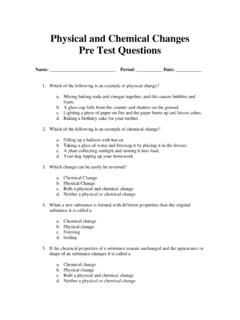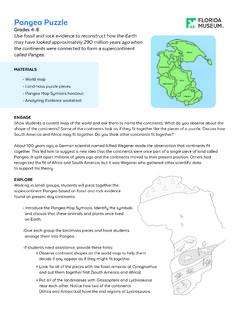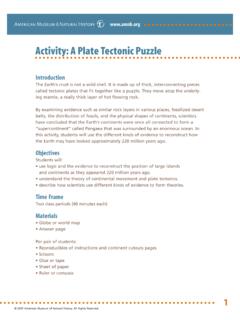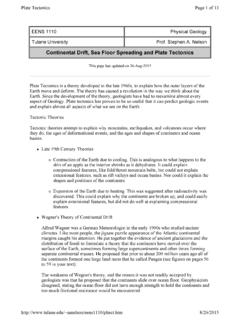Transcription of Continental Drift Activity Packet - Weebly
1 Continental Drift Activity Instructions: You will be piecing together a puzzle of the supercontinent Pangaea based on fossil and rock evidence on the present-day continents. 1. a. Color the legend on the puzzle pieces handout according to the key. b. Use those same colors to color each type of fossil or mountain belt according to your Label the the continents on a piece of construction paper. Move them around using thefossil and mountain chain evidence to match the continents together in the position theywere in when they were part of Pangaea. The pieces may not fit together exactly!4. do you find mountains that are similar to the Appalachians in the eastern UnitedStates?
2 2. Which two continents have the most obvious fit of the coastlines? were the fossil symbols and mountain belts helpful in deciding where to move thecontinents? don t the present shapes of the continents fi t perfectly together? fossil occurs on the most landmasses? is an extinct fern plant that had leaves like ferns today. Where are fossils ofGlossopteris found today? or Not? On the Analyzing Evidence worksheet, read the statement in each box and check whether the statement is evidence or not in the left columns, and whether it supports the movements of the continents in the right columns. Answer the following questions on a separate sheet of paper, two-column is an extinct freshwater reptile that lived millions of years ago.
3 Where arefossils of Mesosaurus found today?When you have assembled Pangaea based on the fossil and rock locations, glue thecontinents on to your construction paper in the shape of the supercontinent. Glue thelegend to your puzzle. Check with your teacher BEFORE you glue!Use scissors to cut along the borders of the continents. These are the approximate shapes of the continents after Pangaea broke up. Key to Wegener s Puzzling Evidence - Fossils By about 300 million years ago, a unique community of plants had evolved known as the European flora. Fossils of these plants are found in Europe and other areas. Color the areas with these fossils YELLOW. Fossil remains of the half meter-long freshwater reptile Mesosaurus.
4 Mesosaurus flourished in the early Mesozoic Era,about 240 million years ago. Mesosaurus had limbs forswimming, but could also walk on land. Other fossil evidence found in rocks along with Mesosaurus suggests that they lived inlakes and coastal bays or estuaries. Color the areas with these fossils BLUE. The Appalachian Mountains of the eastern United States and Canada are similar to mountain ranges in eastern Greenland, western Europe, and Africa. Color areas with these formations BROWN. Fossils of the fern Glossopteris have been found in several locations. Color the areas with these fossils GREEN. Fossil remains of Cynognathus, a land reptile approximately 3meters long that lived during the Early Mesozoic Era, about 230 million years ago.
5 It was a weak swimmer. Color the areas with these fossils ORANGE. Fossil evidence of the Early Mesozoic, land-dwelling reptile Lystrosaurus. They reproduced by laying eggs on land. Inaddition, their anatomy suggests that these animals were probably very poor swimmers. Color the areas with these fossils GRAY. DIRECTIONS: 1) Label each continent with its )Color the fossils or mountains in the legendand color the symbols on each continent in the colors of the legend. 3) Cut out the continents and match up the fossil and mountain evidence torecreate Pangea. 4) Gluethe continents intoplace on and Mountain Chain Department of the Geological SurveyThis Dynamic Planet.
6 A Teaching CompanionWegener s Puzzling Continental Drift Geological Survey, 2008 For updates see < >GreenlandThe European Flora Cynognathus reptile Lystrosaurus reptile Glossopteris plant Mesosaurus reptile Mountain rangesModi ed From:GUSSName _____Analyzing Evidence: Continental : Geologist Eduard Seuss points out that fossils of theGlossopteris plant are found in southern Africa, South America,Australia, Antarctica, and examines the location of tiny rocks and the direction ofgrooves formed by large glaciers scraping across southern areas ofAfrica, South America, Australia, Antarctica, and India. He concludesthat if all these places were fitted together, they would form acontinuous ice sheet expanding outward in all News, January 6,1912: Announcement that Germanscientist Alfred Wegener will speak at the Geological Geology magazine, March 12, 1912: Continents are so largethey must always have been where they are.
7 Observes that a South American mountain range in Argentina m atches up with an ancient African mountain range in South Africa when the two continents are placed together. Hewrites: It is just as if we were to refit the torn pieces of a newspaper by matching their edges and then check whether the lines of print ran smoothly across. If they do, there is nothing left but to conclude that the pieces were in fact joined in this way. : Geologist Alexander du Toit observes rock layers on thewestern coast of Africa in the following sequence: basalt rock, shale containing fossil reptiles, coal layers containing Glossopteris fossils,rocks containing Mesosaurus fossils, and shale.
8 He discovers an almost identical sequence of rock layers on the eastern coast of South : Geologist Baily Willis calls Wegener s theory a fairy tale. Heargues that the theory should be : Geologist Edward Bullard uses computers to match coasts ofSouth America and Africa. They match extremely well at an oceandepth of 1,000 : Satellites and lasers are used to measure the movement of continents. They continue to move at an average of about 2 cm ( in) per of Megascolecina earthworms are found in South America,Africa, India, and Australia, as well as the islands of Madagascarand New NoYes NoDoes it support the idea that the continents have moved?Is it evidence?
9 StatementsPeriod _____




